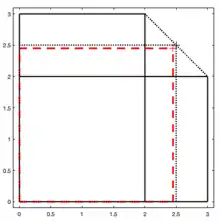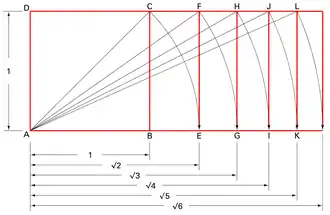Square root of 6
The square root of 6 is the positive real number that, when multiplied by itself, gives the natural number 6. It is more precisely called the principal square root of 6, to distinguish it from the negative number with the same property. This number appears in numerous geometric and number-theoretic contexts. It can be denoted in surd form as:[1]
| Rationality | Irrational |
|---|---|
| Representations | |
| Decimal | 2.449489742783178098..._10 |
| Algebraic form | |
| Continued fraction | |
| Binary | 10.011100110001..._2 |
| Hexadecimal | 2.7311c2812425c..._16 |


and in exponent form as:
It is an irrational algebraic number.[2] The first sixty significant digits of its decimal expansion are:
- 2.44948974278317809819728407470589139196594748065667012843269....[3]
which can be rounded up to 2.45 to within about 99.98% accuracy (about 1 part in 4800); that is, it differs from the correct value by about 1/2,000. It takes two more digits (2.4495) to reduce the error by about half. The approximation 218/89 (≈ 2.449438...) is nearly ten times better: despite having a denominator of only 89, it differs from the correct value by less than 1/20,000, or less than one part in 47,000.
Since 6 is the product of 2 and 3, the square root of 6 is the geometric mean of 2 and 3, and is the product of the square root of 2 and the square root of 3, both of which are irrational algebraic numbers.
NASA has published more than a million decimal digits of the square root of six.[4]
Rational approximations
The square root of 6 can be expressed as the continued fraction
The successive partial evaluations of the continued fraction, which are called its convergents, approach :
Their numerators are 2, 5, 22, 49, 218, 485, 2158, 4801, 21362, 47525, 211462, …(sequence A041006 in the OEIS), and their denominators are 1, 2, 9, 20, 89, 198, 881, 1960, 8721, 19402, 86329, …(sequence A041007 in the OEIS).[5]
Each convergent is a best rational approximation of ; in other words, it is closer to than any rational with a smaller denominator. Decimal equivalents improve linearly, at a rate of nearly one digit per convergent:
The convergents, expressed as x/y, satisfy alternately the Pell's equations[5]
When is approximated with the Babylonian method, starting with x0 = 2 and using xn+1 = 1/2(xn + 6/xn), the nth approximant xn is equal to the 2nth convergent of the continued fraction:

The Babylonian method is equivalent to Newton's method for root finding applied to the polynomial . The Newton's method update, is equal to when . The method therefore converges quadratically.
Geometry



In plane geometry, the square root of 6 can be constructed via a sequence of dynamic rectangles, as illustrated here.[6][7][8]
In solid geometry, the square root of 6 appears as the longest distances between corners (vertices) of the double cube, as illustrated above. The square roots of all lower natural numbers appear as the distances between other vertex pairs in the double cube (including the vertices of the included two cubes).[8]
The edge length of a cube with total surface area of 1 is or the reciprocal square root of 6. The edge lengths of a regular tetrahedron (t), a regular octahedron (o), and a cube (c) of equal total surface areas satisfy .[3][9]
The edge length of a regular octahedron is the square root of 6 times the radius of an inscribed sphere (that is, the distance from the center of the solid to the center of each face).[10]
The square root of 6 appears in various other geometry contexts, such as the side length for the square enclosing an equilateral triangle of side 2 (see figure).
Trigonometry
The square root of 6, with the square root of 2 added or subtracted, appears in several exact trigonometric values for angles at multiples of 15 degrees ( radians).[11]
:{| class="wikitable" style="text-align: center;"
!Radians!!Degrees!!sin!!cos!!tan!!cot!!sec!!csc |- ! !! ||| || || || || |- ! !! ||| || || || || |}
In culture

The square root of six (actually its reciprocal, "the square root of six over six") appears in Star Wars dialogue.[12]
The question of "whether the square root of six is three" has been posited as a question that might be answered by economic methods, if social issues can be so addressed.[13][14][15][16]
Villard de Honnecourt's 13th century construction of a Gothic "fifth-point arch" with circular arcs of radius 5 has a height of twice the square root of 6, as illustrated here.[17][18]
References
- Ray, Joseph (1842). Ray's Eclectic Arithmetic on the Inductive and Analytic Methods of Instruction. Cincinnati: Truman and Smith. p. 217. Retrieved 20 March 2022.
- O'Sullivan, Daniel (1872). The Principles of Arithmetic: A Comprehensive Text-Book. Dublin: Alexander Thom. p. 234. Retrieved 17 March 2022.
- Sloane, N. J. A. (ed.). "Sequence A010464 (Decimal expansion of square root of 6)". The On-Line Encyclopedia of Integer Sequences. OEIS Foundation.
- Robert Nemiroff; Jerry Bonnell. "the first 1 million digits of the square root of 6". nasa.gov. Retrieved 17 March 2022.
- Conrad, Keith. "Pell's Equation II" (PDF). uconn.edu. Retrieved 17 March 2022.
The continued fraction of √6 is [2; 2, 4], and the table of convergents below suggests (and it is true) that every other convergent provides a solution to x2 − 6y2 = 1.
- Jay Hambidge (1920) [1920]. Dynamic Symmetry: The Greek Vase (Reprint of original Yale University Press ed.). Whitefish, MT: Kessinger Publishing. pp. 19–29. ISBN 0-7661-7679-7.
Dynamic Symmetry root rectangles.
- Matila Ghyka (1977). The Geometry of Art and Life. Courier Dover Publications. pp. 126–127. ISBN 9780486235424.
- Fletcher, Rachel (2013). Infinite Measure: Learning to Design in Geometric Harmony with Art, Architecture, and Nature. George F Thompson Publishing. ISBN 978-1-938086-02-1.
- Rechtman, Ana. "Un défi par semaine Avril 2016, 3e défi (Solution du 2e défi d'Avril)". Images des Mathématiques. Retrieved 23 March 2022.
- S. C. & L. M. Gould (1890). The Bizarre Notes and Queries in History, Folk-lore, Mathematics, Mysticism, Art, Science, Etc, Volumes 7-8. Manchester, N. H. p. 342. Retrieved 19 March 2022.
In the octahedron whose diameter is 2, the linear edge equals the square root of 6.
{{cite book}}: CS1 maint: location missing publisher (link) - Abramowitz, Milton; Stegun, Irene A., eds. (1972). Handbook of Mathematical Functions with Formulas, Graphs, and Mathematical Tables. New York: Dover Publications. p. 74. ISBN 978-0-486-61272-0.
- Hearne, Kevin (2015). Heir to the Jedi: Star Wars. Random House. p. 122. ISBN 9780345544872. Retrieved 20 March 2022.
...with the associated vectors square root of six over six times the vector one, one, two...
- Sagoff, Mark (1981). "At the shrine of Our Lady of Fatima or why political questions are not all economic". Arizona Law Review. 23: 1283–1298. Retrieved 24 March 2022. (reprinted)
- Tverdek, Edward F. (2015). The Moral Weight of Ecology: Public Goods, Cooperative Duties, and Environmental Politics. Lexington Books. p. 214. ISBN 9781498514545. Retrieved 20 March 2022.
- Louis P. Pojman; Paul Pojman; Katie McShane (2016). Environmental Ethics: Readings in Theory and Application. Cengage. p. 448. ISBN 9781305687806. Retrieved 20 March 2022.
- Lawrence Susskind; Bruno Verdini; Jessica Gordon; Yasmin Zaerpoor (2020). Environmental Problem-Solving: Balancing Science and Politics Using Consensus Building Tools. Anthem Press. p. 377. ISBN 9781785271328. Retrieved 20 March 2022.
- Branner, Robert (1960). "Villard de Honnecourt, Archimedes, and Chartres". Journal of the Society of Architectural Historians. 19 (3): 91–96. doi:10.2307/988023. JSTOR 988023. Retrieved 25 March 2022.
- Shelby, Lon R. (1969). "Setting Out the Keystones of Pointed Arches: A Note on Medieval 'Baugeometrie'". Technology and Culture. 10 (4): 537–548. doi:10.2307/3101574. JSTOR 3101574. Retrieved 25 March 2022.
